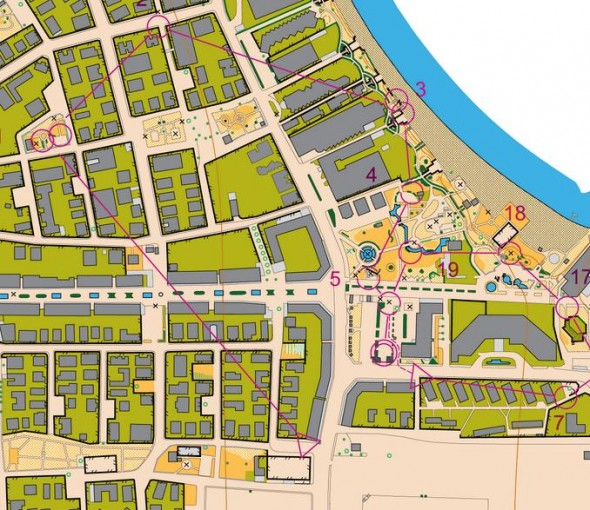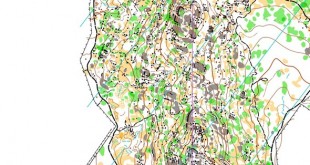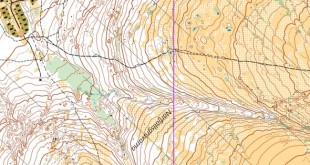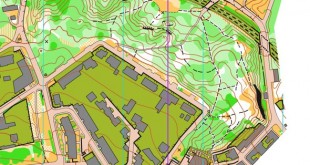
The first ever (unofficial) World Cup race in Mixed Sprint Relay was run last Sunday in Turkey. What is your opinion about the “new” race format – and how well did it work in Turkey?
Was it fun to run? Yes (Gustav Bergman)
All participants (athletes, coaches, officials) are asked to fill out an online-form prepared by the athletes commission/foot-o commision – this will be very important for the evaluation of the race format – and therefore all runners are strongly encouraged to fill out the form (this is were opinions will certainly be read).
As the online form is “only” for participants in the race, it would be very interesting to hear the opinion the readers of World of O in the comments below (participants are of course especially invited to offer their opinion and take part in a discussion).
Some comments from around the Internet
I can’t help to think of it as a bit of a joke (Gustav Bergman)
- Gustav Bergman on his webpage:
I can’t help to think of it as a bit of a joke. I think that the introduction of this dicipline on the WOC programme really shows that the International Orienteering Federation makes very strange priorities sometimes. One would assume that the biggest reason to extend the WOC programme by including the sprint relay is to make orienteering more spectator friendly. I can accept that vision, but I believe that a sprint relay is completely the wrong way to go. It is just too messy and and hard to understand for non-orienteerers. And we could also see that the format favours the big orienteering countries like Sweden and Switzerland, so it is not good for spreading the WOC medals to new nations either… Was it fun to run? Yes (despite the obvious lack of gaffling, and the very non-demanding and boring course). Was it spectator friendly? No, not especially. - Judith Wyder on her webpage:
It was my first time running a sprint relay with emits- touch free and I have to say it’s a bit special to just pass the controls without stopping and punching. But I think it’s going to be a really interesting new world champs competition this summer. - Øystein Kvaal Østerbø’s blog (guest post by other members of the Norwegian Team:
– Even though people have different opinions about this relay format, it is taken seriously by all the athletes and we have ambitions to fight for medals at WOC. - Lina Strand on her webpage:
Maybe it does not sound so important with an inofficial cup, but considering that there will be medals in this discipline at the World Champs in Italy this summer, it is very important for the team. […] Forbidden areas were not included on the GPS-version of the map – our map looked differently. - EMIT’s Tommy Jauhojärvi (via e-mail):
Everything worked 100% as it should. Super feedback from the runners. Nobody was disqualified due to missing punch. All disqualifications were due to runners having been at the wrong control or not seen a control [on the map]. Many gave positive feedback on the fact that you had to get very close to the control when you run fast to get a valid punch. - O-zeugs commented on the World of O article from World Cup mixed sprint relay:
The running momentum seemed pretty dominant and because of the outbalanced route choices it was not useful to take a different choice than the pack leader. To change this one would expect more forkings to influence the route choices alike at the 3rd control of the womens course. (For one forked control the one choice is favourable, for the other the other route is). - Eric commented on the World of O article from World Cup mixed sprint relay:
In my opinion it was very very boring to watch (with gps only). Maybe it was cool for some spectators, because you see the runners and then hope after they disappeared that your favourite runners shows up first. But with easy course and gps its only boring. You always see who is in front and there arent many changes (except for misspunches wich you couldnt see because you didnt knew wich control needs to be taken by who. The only thing that was maybe interesting was, to see how runners who almost catched up some pack in the front choose their next leg. If they just fallow or try an other choice to gain some time.
It is taken seriously by all the athletes and we have ambitions to fight for medals at WOC
The running momentum seemed pretty dominant and because of the outbalanced route choices it was not useful to take a different choice than the pack leader
Background info: The Mixed Sprint Relay format
The Mixed Sprint Relay consists of 4 legs – each with around 15 minutes winner time. Women run the first and last leg – men the 2nd and 3rd leg. There is forking – although not very much in Turkey (and probably there should not be very much forking in this format either). Touch free punching is used. According to the definition of the format, there shall be a spectator control dividing the courses into two loops.
See also:
 World of O News
World of O News






I don’t understand why it should always be Women-Man-Man-Women. Can’t it alternate year to year which gender runs the decisive last leg, like at 25manna?
I fully agree, Helen! The argument for why women should be first/last was not impressive either.
The arguement I heard was somekind of insulting gender stereotyping that having supposedly emotionally unstable women on the last leg would create more “drama”… I would go so far as to call it “gaslighting”, an insidious tactic used – mostly by men – to make women feel like they are “just a little crazy” and doubt themselves.
But hey I’m probably overreacting, overthinking, being overly dramatic.. I mean imagine a World class MALE orienteer doing something dramatic like missing out a control on the last leg of a big relay… that would NEVER happen right??
I agree that alternating the last leg each year makes sense, if for no reason other than the runners’ experience, women always having the pressure legs would be unfair, but probably also less fun for the men.
With regard to the theory that women’s final leg being more dramatic, while that certainly does seem like gender stereotyping (maybe not quite gas-lighting in my eyes…), and despite us having some seriously dramatic men’s last legs over the previous years, I do still think they’re probably not far wrong.
The top women seem to have more mistakes than the top men, and mistakes do make for excitement…
@Helen https://www.youtube.com/watch?v=-XskezsL0Ws don’t think that was a men relay.
Yeah I didn’t get to see that race live because I was in the forest making huge mistakes..
Whether the format was based on gender stereotyping or not, it doesn’t seem to be fair. It should alternate.
Re: the tennis reference given was not really relevant but mixed doubles features in all grand slams. Both genders get roughly equal chances to serve and receive. It is usually pretty entertaining to watch and has less prestige than singles.
I don’t think girls on the big legs implies that they’re more liable to crack, just that it’ll be entertaining. Like women’s tennis isn’t entertaining because they make more mistakes but because it’s good tennis.
I think always having men on the less exciting legs though suggests men’s orienteering is less exciting; alternating would be a good idea
Personally I dont like new formats like that. But if they want them then why not make them even more diffrent?
If the sprint-area is that easy, I would love to have a part that can mix things up more. Like a small detailed area with 4-5 controls in free order. They could even be forked, so most of runners need to take they own choices.
Like that you create a short time where its not clear who is in lead and can mix things up again. (more like in biathlon where the shooting can mix things up again). In my opinion this would create some excitement because you need to be unsecure who is in lead for some time.
One biathlon variation which might works…
Leg 1: One course / common start
Leg 2: Forked controls
Leg 3: Forked controls
Leg 4: One course / penalty loop
Based on 6x intermediate times of first and second runner(course sections/start-radio c.-radio c.- finish) each team would get separate rank for each section and summed final rank after second runner.
This would give each team information if 4th runner needs to run additional 200m/300m penalty loop right after 4th exchange.
First and second runner would need to push hard because it is not necessary that the best team on 3rd exchange would get Nr. 1 rank based on intermediate times. Also team with mistakes would have chance to bring team back with good performance on the other course sections and gain first spot based on intermediate times.
Only the best ranked team would gain. Securing 1st rank would give a team advantage and additional drama on 4th leg. Other teams would need to run penalty loop; 2-10th teams – 200m and teams from 10 onwards 300m meters.
In this way we could have one course for Leg 1&4 and clear information who is leading for the whole 4th leg.
Why not just do as in World games? But mixrelay is not a part of the olympics in any sport…
There was a mixed relay in biathlon at then olympics in Russia.
Was it fun or not – I’m unable to say.
But I keep asking myself questions: Do we still belive orienteering could be attractive to spectators? Should we continue to make TV-formatted variants when TV is no longer so important as it once was?
For me orienteering is a spectacular sport… for orienteers only!
Orienteering has many factors very important in current and future world: nature, self-confidence, family (courses for everyone), endurance. I think it’s enough, we shouldn’t try to be also a show.
Baptiste Rollier: “The sprint relay was a fun competition to run and to watch. I was in a “out off competition” team with Mette and Camilla from Denmark and Raffi. In my opinion it can be a good format for international events. Improvement can be made in the gaffling system and course which should offer many route choices in order to split and to trap the runners which are not active on the map. Nevertheless we should not forget that existing orienteering competition are really good already and that we should focus on presenting/broadcasting the actual distances in a professional way instead of inventing new discipline.” Baptiste Rollier http://baptisterollier.blogspot.se/2014/03/season-start-in-turkey.html
Martin Hubmann:
“I would prefer more distinct forkings to demand more initiative from the runners and to separate them more. To make it look less like a road race, would also make it more interesting for the spectators and at the same time it would decrease the number of disqualifications. This was only the beginning of the sprint mixed relay, so I hope the discipline will develop further towards WOC.” http://www.martinhubmann.ch/news/102-weltcupauftakt-in-der-tuerkei
We recently had a sprint relay in Australia:
http://www.orienteering.asn.au/news/?ItemID=9851
I competed in this elite race, and while i despise what the IOF has done to orienteering in recent years (including the sprint relay) I think the courses were excellent and made to produce exciting racing with lead changes and all that stuff.
How did they do it? simple! they just set 4 seperate courses and each team ran them in a different order.
at WOC of course, you could only randomise them into 2 sets of 2 (for men and women)